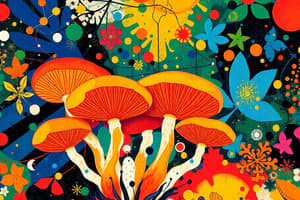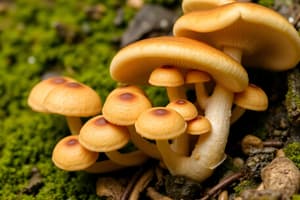Podcast
Questions and Answers
Which characteristic distinguishes fungi from plants?
Which characteristic distinguishes fungi from plants?
- Cell walls made of chitin (correct)
- Presence of cell walls
- Heterotrophic mode of nutrition
- Mode of reproduction through spores
How do mycorrhizae enhance plant growth and survival?
How do mycorrhizae enhance plant growth and survival?
- Aiding in pollination
- Enhancing nutrient and water absorption (correct)
- Producing antibiotics to fight plant pathogens
- Protecting plants from herbivores
What role do fungi primarily play in nutrient cycling within an ecosystem?
What role do fungi primarily play in nutrient cycling within an ecosystem?
- As top predators, controlling herbivore populations
- As pollinators, facilitating plant reproduction
- As primary producers, converting sunlight into energy
- As decomposers, breaking down organic matter (correct)
What is the primary ecological role of Cordyceps fungi?
What is the primary ecological role of Cordyceps fungi?
Which of the following is a key characteristic of Ascomycota (sac fungi)?
Which of the following is a key characteristic of Ascomycota (sac fungi)?
How do lichens contribute to environmental monitoring?
How do lichens contribute to environmental monitoring?
What is the significance of choanocytes in Porifera (sponges)?
What is the significance of choanocytes in Porifera (sponges)?
Cnidarians possess specialized stinging cells called cnidocytes. What is the primary function of cnidocytes?
Cnidarians possess specialized stinging cells called cnidocytes. What is the primary function of cnidocytes?
Which of the following features is characteristic of Bilateria?
Which of the following features is characteristic of Bilateria?
How do fungi interact with animals to form a mutualistic association?
How do fungi interact with animals to form a mutualistic association?
What is the primary role of hyphae in fungal biology?
What is the primary role of hyphae in fungal biology?
How would a lack of fungi in an ecosystem affect plants?
How would a lack of fungi in an ecosystem affect plants?
What is the defining characteristic of Eumetazoa?
What is the defining characteristic of Eumetazoa?
What distinguishes vertebrates from other Bilateria?
What distinguishes vertebrates from other Bilateria?
What is the function of the osculum in sponges (Porifera)?
What is the function of the osculum in sponges (Porifera)?
What is the ecological significance of fungi forming lichens?
What is the ecological significance of fungi forming lichens?
How does sexual reproduction in Basidiomycota (club fungi) occur?
How does sexual reproduction in Basidiomycota (club fungi) occur?
What is the primary advantage of bilateral symmetry in animals?
What is the primary advantage of bilateral symmetry in animals?
Which of the following describes the interaction between plants contributing carbohydrates to fungi via mycorrhizal partnerships?
Which of the following describes the interaction between plants contributing carbohydrates to fungi via mycorrhizal partnerships?
What is the primary criterion used to classify lichens?
What is the primary criterion used to classify lichens?
Flashcards
Opisthokonta
Opisthokonta
A supergroup of Eukaryota including fungi and animals.
Fungi
Fungi
Organisms like yeasts, molds, and mushrooms which decompose matter and form symbiotic relationships.
Mycelium
Mycelium
The vegetative body of a fungus, consisting of a mass of thread-like filaments.
Chitin
Chitin
Signup and view all the flashcards
Mycorrhizal Fungi
Mycorrhizal Fungi
Signup and view all the flashcards
Cordyceps
Cordyceps
Signup and view all the flashcards
Ascomycota
Ascomycota
Signup and view all the flashcards
Basidiomycota
Basidiomycota
Signup and view all the flashcards
Lichens
Lichens
Signup and view all the flashcards
Eumetazoa
Eumetazoa
Signup and view all the flashcards
Bilateria
Bilateria
Signup and view all the flashcards
Vertebrates
Vertebrates
Signup and view all the flashcards
Porifera
Porifera
Signup and view all the flashcards
Osculum
Osculum
Signup and view all the flashcards
Cnidaria
Cnidaria
Signup and view all the flashcards
Cnidocytes (Nematocysts)
Cnidocytes (Nematocysts)
Signup and view all the flashcards
Suspension Feeders
Suspension Feeders
Signup and view all the flashcards
Cephalization
Cephalization
Signup and view all the flashcards
Ectomycorrhizal fungi
Ectomycorrhizal fungi
Signup and view all the flashcards
Arbuscular mycorrhizal fungi
Arbuscular mycorrhizal fungi
Signup and view all the flashcards
Study Notes
- Opisthokonta is a supergroup in the domain Eukaryota.
- Fungi and Animals are included in the Opisthokonta supergroup.
- Molecular evidence indicates fungi and animals share a more recent common ancestor than either does with plants.
Contributions of Fungi to Ecosystem
- Fungi act as decomposers, breaking down dead organic matter and recycling nutrients like carbon, nitrogen, and phosphorus into the soil.
- Fungi form symbiotic relationships, including mycorrhizae with plant roots to aid in nutrient absorption, and as lichens with algae or cyanobacteria.
- Fungi are used as food, in fermentation (yeasts for bread and beer), and in medicine (e.g., Penicillium).
Fungal Structures, Distinguishing Features, and Biology
- Hyphae are long, thread-like filaments that make up the mycelium of fungi.
- Mycelium is a mass of hyphae that forms the vegetative body.
- Chitin is the main structural component of the fungal cell wall, distinguishing them from plants.
- Asexual reproduction in fungi occurs via spores, such as conidia and sporangia, while sexual reproduction occurs through specialized fruiting bodies.
Mycorrhizal Fungi & Cordyceps
- Mycorrhizal fungi are symbiotic fungi associated with plant roots, enhancing plant nutrient and water absorption in exchange for carbohydrates.
- Ectomycorrhizal fungi sheath plant roots, while arbuscular mycorrhizal fungi penetrate root cells.
- Cordyceps are parasitic fungi that infect insects or other arthropods, growing inside the host, eventually killing it and releasing spores.
Ascomycota, Basidiomycota, & Lichens – Anatomy and Features
- Ascomycota (Sac Fungi) produce sexual spores (ascospores) in an ascus and reproduce asexually via conidia. Examples include yeasts, truffles, and molds.
- Basidiomycota (Club Fungi) produce sexual spores (basidiospores) on basidia and examples include mushrooms, puffballs, and rusts.
- Lichens are a symbiotic association between fungi and photosynthetic organisms (algae or cyanobacteria) and are classified by their fungal partner (Ascomycota or Basidiomycota). They serve as bioindicators of environmental health.
Relationship Between Plants, Fungi, and Animals
- Plants provide carbohydrates to fungi via mycorrhizal partnerships.
- Fungi decompose organic material and form symbiotic relationships with plants and animals.
- Fungi can be parasitic on animals (e.g., Cordyceps) or form mutualistic relationships, such as in herbivore guts.
Eumetazoa, Bilateria, Vertebrates in Animals
- Eumetazoa are animals with true tissues (excluding sponges).
- Bilateria are animals with bilateral symmetry and cephalization, including most animals.
- Vertebrates are a subgroup within Bilateria that have a backbone/spinal column. Examples include mammals, birds, and reptiles.
Porifera: Types of Cells, Osculum, Suspension Feeders
- Porifera (sponges) are simple, multicellular organisms without true tissues.
- Choanocytes filter food particles from water, while amoebocytes distribute nutrients and secrete spicules.
- Osculum is the opening where water exits the sponge.
- Sponges are suspension feeders, filtering small particles like plankton from water.
Cnidaria: Diploblastic, Tissues, Radial Symmetry, Cnidocytes (Nematocysts), Sedentary and Mobile Forms
- Cnidaria includes jellyfish, corals, and sea anemones.
- Cnidarians are diploblastic, having two germ layers (ectoderm and endoderm) with radial symmetry.
- Cnidocytes (nematocysts) are specialized stinging cells used for prey capture.
- Some cnidarians are sedentary (e.g., corals, sea anemones), while others are mobile (e.g., jellyfish).
Studying That Suits You
Use AI to generate personalized quizzes and flashcards to suit your learning preferences.





